
|
Science Information
What
Scientists Say About the Spirit Bear
What is a Spirit Bear?
Scientists recognize the spirit bear or Kermode bear as a Canadian subspecies of the North American black bear species. About one in 10 Kermode bears is white. The term "Kermode bear" is derived from the scientific name Ursus americanus kermodei. |
The
bear is also known as the "spirit bear"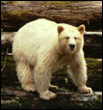 or
"ghost" or "white" bear. Both black and white
individuals are called Kermode or spirit bears. The white individuals
are not albinos, they have a white or cream-coloured coat but dark
footpads, nose and eyes as do other bears. or
"ghost" or "white" bear. Both black and white
individuals are called Kermode or spirit bears. The white individuals
are not albinos, they have a white or cream-coloured coat but dark
footpads, nose and eyes as do other bears.
Although
the occasional white bear has been reported elsewhere in populations
of the North American black bear, the Kermode bear subspecies is
confined to the central and north coast of British Columbia.
Currently,
the genetic mechanisms that trigger such a high percentage of white
bears to appear in the population are poorly understood. Scientists
speculate that a double-recessive gene for coat colour may be responsible.
But even though spirit bear genetics require more study, scientists
consider preserving a gene pool that produces 10% or more white-phased
individuals to be important.
Even more important, recent DNA studies on the central coast show that the incidence of white-phased Kermodes varies between islands and between islands and the mainland. Some key islands have about 10% white-phased, while on smaller Gribbell Island over 30% of the population is white bears. On the nearby mainland, the incidence of white individuals is less than 1/2 percent, the rest are black. To protect this unique genetic variation, it will be important to work to protect more spirit bear habitat beyond what is currently agreed to. For example, Gribbell Island and Green Inlet-Valley need full protection, which we had originally proposed but was denied for political reasons in the previous land-use planning processes.
Top
Where
do Spirit Bears Live?
Spirit
bears inhabit the lush, coniferous rainforests of the mid and north coast
of British Columbia, where the trees grow large because of the very
wet climate and few fires. Inland, along the Skeena River, spirit
bears also inhabit some drier-type forests. Most forest habitats
used by spirit bears grow to be very old, especially along the stormy
edge of the continent at the interface between the Pacific Ocean
and the coastal mountains.
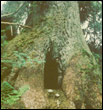 |
| A
bear den in the base of an ancient tree. Logging removes these
trees and the bears winter homes. |
It
is because of the shelter provided by large, old trees that the
spirit bears (and their distant cousins, the grizzly bears) can
survive inhospitable winters of cold rain, driving snow and unrelenting
dampness. Some of the larger trees have dry hollow interiors that provide
den sites for hibernation. Most den trees are over one metre diameter and over 500 years old. Such ancient trees are also the birthing places for spirit bears. Curled up for the winter inside these giant trees, pregnant Kermode females give birth to tiny bears while still in the slumber of hibernation.
These
ancient forest ecosystems support 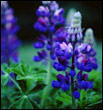 the
spirit bear in other ways as well. They produce a variety and abundance
of plant foods and support healthy watersheds for salmon – the mainstays
in the diet of spirit bears and grizzly bears in the autumn. the
spirit bear in other ways as well. They produce a variety and abundance
of plant foods and support healthy watersheds for salmon – the mainstays
in the diet of spirit bears and grizzly bears in the autumn.
Top
Scientists Conclude Logging Would Drive
Out Spirit Bears
In
British Columbia, until recently, no studies had been done on the
environmental impacts of extensive logging on the spirit bear and
other rainforest denizens. Now, however, a five-year review has
been completed by a team of scientists under the auspices of the
Valhalla Wilderness Society. Their research has shown that much
of the spirit bear's historic range in British Columbia has been
heavily clearcut logged and invaded by roads built by logging companies,
mining operations and other forms of human encroachment.
The
study concluded that extensive clearcutting and roading jeopardizes
the long-term survival of spirit bears. The impact review showed
that the massive clearcut logging planned for the proposed sanctuary area would cause long-term degradation
of bear feeding and winter denning habitats, as well as the loss
of salmon that the bears feed on every fall in order to fatten up
for their winter hibernation. When scientists looked at a 100-year
logging cycle, they concluded that the loss of habitat would jeopardize
the survival of the spirit bear.
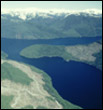 |
Typical
Logging in
spirit bear habitat. |
Research
done in similar ecosystems in Alaska (e.g. in the Tongass coastal
rainforest) has shown that clearcut logging has a marked impact
on many species including bears. The research done in Alaska on
logging and wilderness has prompted the United States government
to protect much larger areas in Alaska than are protected or even proposed for protection in coastal
British Columbia.
The
science reports sponsored by the Valhalla Wilderness Society provided
the first comprehensive review of the genetics, ecology and conservation
status of spirit bears.
Scientists
were disturbed to find there are no government guidelines related
to logging to adequately protect spirit bears and many other species.
A previous British Columbia government study of grizzly bears conducted in
the Khutzeymateen Valley (a coastal valley in the north of the spirit bear's
range) concluded that the ecosystem could not be logged without
doing irreparable damage to grizzly bears. Valhalla Wilderness Society
bear biologists and other scientists have concluded the same is
true for other coastal areas inhabited by spirit bears and grizzly
bears.
During the recent land use planning processes, a new way of logging was recommended called ecosystem-based management (EBM). Unfortunately the original biologically based guidelines to achieve this were so watered down by the government that many independent scientists believe they are now too weak. For example, there is not enough protection allowed of old-growth habitats for winter dens for Kermode and grizzly bears, nesting marbled murrelets (a rare seabird that nests on branches in old trees) and Sitka deer winter sites. These habitat needs often overlap with the areas of highest commercial value to the logging companies. Additionally, protective forest buffers proposed along salmon streams will be too narrow to be of value. Worse, the guidelines will not be enacted until 2009 so the timber industry can basically continue to wreck forever many remaining ancient forest valleys as it has done in the past. In 2006, the province approved raw log exports of 9,600 truckloads meaning industry will cream the ancient forests outside of protected areas well before EBM guidelines are phased in. What will be left?
Top
Ancient
Forests Necessary for Bear's Survival
The
coastal forests of British Columbia are known as "mountain
protection forests." Here, the extensive root structures of
old trees anchor thin soil to steep mountainsides. Once trees are
removed, landslides increase dramatically. The thin soils overlaying
bedrock, combined with dense rainfall and high winds – a result
of frequent storms that rage in from the Pacific – lead to landslides
that erode mountainsides and destroy critical bear feeding areas
and salmon streams.
When
biologically diverse ancient forests are logged, the forestry companies
replant them with tiny seedlings of a few selected commercial tree
species. These seedlings grow into dense second-growth plantation
forests that provide poor habitat for bears. The conversion of ancient
forests, abundant with lush bear foods, into sterile, even-aged
forests in which bears and other animals starve, is another unfortunate
outcome of widespread clearcut logging of the rainforest. Many of these
ancient forests should simply never be logged but left to do what they
were created for – to hold up the mountainsides, shelter inland
areas from raging coastal storms, and provide natural habitat for
spirit and grizzly bears, Sitka deer, wolves, salmon and hundreds
of other inter-related species.
Top
Creating
a Safe Haven for the Spirit Bear
Scientists
now recognize that wild mammals which require
large areas for their home territories cannot live in
small patches of habitat in isolated sanctuaries. 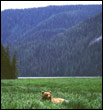 These
species will eventually go extinct; such is the sad situation for
the Panda bear in China that now hovers on the brink of disappearing
forever. Scientists have learned that animals such as bears and
wolves need very large areas of intact habitat if they are to survive
in their wild state. These
species will eventually go extinct; such is the sad situation for
the Panda bear in China that now hovers on the brink of disappearing
forever. Scientists have learned that animals such as bears and
wolves need very large areas of intact habitat if they are to survive
in their wild state.
Until
conservationists such as those with the Valhalla Wilderness Society
stepped in and loudly demanded better protection for British Columbia's
wildlife, the British Columbia government's plan for protection
of the Central Coast included only a few small, isolated parks that
would have become islands of extinction for wide-roaming bears and
wolves.
About
18 years ago, Valhalla Wilderness Society researchers in cooperation
with First Nations people of the area identified Princess
Royal Island and adjacent mainland areas to be one of the last remaining
large intact areas suited for a carnivore preserve. Scientists hired
by the Valhalla Wilderness Society used the Kermode bear, grizzly
bear, wolf, Sitka deer and 5 salmon species as "focal species"
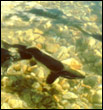 around
which they designed a proposal for a 262,000 hectare (650,000 acre)
conservancy area. These key species served as "umbrella species"
to protect many or all of the other species in the ecosystem. around
which they designed a proposal for a 262,000 hectare (650,000 acre)
conservancy area. These key species served as "umbrella species"
to protect many or all of the other species in the ecosystem.
While
the proposed conservancy may have seemed a large area to the lay person,
scientists considered this the minimum needed for the long-term
survival of wide-ranging spirit bears, grizzly bears and packs of
wolves. The conservation area design included intact habitats on
large and small islands as well as a complex of valleys on the mainland
just opposite Princess Royal Island.
According to Dr. Paul Paquet, an internationally recognized carnivore specialist: "Based on the best conservation design and ecological analysis, we found very high values of intact habitats for  such focal species as wolves, Sitka deer, Kermode and grizzly bears that fully justified protection of the entire 262,000 hectare spirit bear proposal." An analysis by Dr. James Bergdahl of the Conservation Biology Center considered the 50+ salmon streams in the proposal to be a major attribute for a large carnivore preserve. Bear biologist Wayne McCrory found that the spirit bear proposal area represented one of the highest quality intact habitats for both Kermode and grizzly bears on the B.C. coast. such focal species as wolves, Sitka deer, Kermode and grizzly bears that fully justified protection of the entire 262,000 hectare spirit bear proposal." An analysis by Dr. James Bergdahl of the Conservation Biology Center considered the 50+ salmon streams in the proposal to be a major attribute for a large carnivore preserve. Bear biologist Wayne McCrory found that the spirit bear proposal area represented one of the highest quality intact habitats for both Kermode and grizzly bears on the B.C. coast.
A 1999 Conservation Area Design for the British Columbian Central Coast, prepared by internationally recognized conservation biologists, concluded that at least 50% of this ecosystem must be protected for wide-roaming wildlife such as grizzly bears. The Conservation Area Design recommended setting aside 3 large "Core Carnivore Conservation Areas" connected by well-managed corridors or linkage zones. One of the large protection areas recommended included the area encompassed by the Valhalla Wilderness Society's proposed conservancy for spirit bears. All environmental groups involved in coastal protection issues, including VWS, signed a protocol agreeing to work towards protection of a minimum of 40–60% of the B.C. Coast. In 2003 an environmental sensitivity analysis (ESA) by 17 scientists concluded that a minimum of 44–50% of the coastal rainforest needed to be fully protected if biodiversity was to persist. Again, the spirit bear sanctuary proposal ranked very high on their biodiversity maps.
In
the United States, sanctuaries for black bears have been established
as a result of recommendations by leading bear biologists. These
measures, such as in North Carolina and Tennessee, have proven to
be strong conservation tools. Canada has lagged far behind and in
many areas black bears are still needlessly shot as vermin. In fact,
British Columbia has become known as the bear killing capital of
the world. (It should be noted that although white spirit bears
have been legally protected from hunting since the mid-1960s, poaching
does occur. The Valhalla Wilderness Society has an anti-poaching fund to help counter this.)
Top
Spirit bear protection finally announced in 2006
On April 4, 2001, a landmark protocol was signed between the British Columbia provincial government of the time and First Nations governments to establish a "Spirit Bear Protection Area," as well as protect many other key bear-salmon habitats on the B.C. Coast. For the Spirit Bear Area, this was a direct result of the Valhalla Wilderness Society's long-term scientific work and publicity efforts. Thousands of supporters played a key role in moving the provincial and First Nations governments towards a commitment to protection. We had hoped for final protection in 2001 but this did not happen. The spirit bear proposal instead was rolled into other coast-wide lengthy planning reviews over the next 5 years.
In late 2004, the province's coast-wide land use plans and many other First Nations plans were finally completed, recommending protection of some 32% of the north and central coast. This was still short of the 44% minimum recommended by the blue-ribbon science panel. In 2005, the province and First Nations negotiated final terms call G2G or "government-to-government" agreements. Finally on February 7, 2006, the province and First Nations announced protection of some 34% of the coast, 28% of which would be fully protected as conservancies. This included over 212,415 hectares of a complex of large and small protection of spirit bear habitats – some 80% of our original proposal. As well, the Khutzeymateen Grizzly Sanctuary, protected in 1993 after an 8-year campaign spearheaded by VWS, will be tripled to a protected complex of 143,000 ha (350,000 acres). Seaward, the Dundas archipelago of rainforest islands, which we proposed for protection in 1987, will now have its whole island maze of 23,645 ha (58,000 acres) protected.
None of this would have happened without the First Nations and the thousands of you who gave support. Thanks goes to all of you and, in particular, the Kitasoo and Gitga'at First Nations who made the spirit bear protection possible.
Top
What
Still Needs to be Saved
On April 24, 2006 the province announced formal legislation of 24 of the 108 new areas to be protected as conservancies on the B.C. coast. The rest will be protected by 2007. The April 24 legislation includes 10 new conservancies that will comprise the complex of protected lands of spirit bear habitats totaling some 212,415 ha. The Park Act was changed to create a new type of conservancy designation that was more suitable to First Nations interests. Although this is all important, the provincial government also used these legitimate changes for First Nations to provide for a weaker form of protection that, instead of promised protection equal to or greater than Class A parks, will allow for private commercial interests to invade the new conservancies to build high-end tourism lodges, run-of-the-river hydro-electric plants, logging roads and even salvage logging. Such uses are not traditional aboriginal uses. Twelve of the 108 new protection areas will have roads allowed through them to access resources beyond. VWS is concerned that this is just a betraying foot in the door for the province to continue to undermine the desires of First Nations and the public-at-large to fully protect these areas for bears, salmon and all biodiversity for all times.
Nonetheless, the new spirit bear conservancy complex represents about 50% protection of the traditional territories of the Kitasoo and Gitga'at First Nations and some 80% of our original spirit bear sanctuary proposal. Scientists such as Dr. Paul Paquet feel that a number of other critical spirit bear areas need to be protected if the spirit bear sanctuary is to be completed for all time. VWS will continue dialogue with First Nations and others on adding protection of key ecological habitats including the Green Inlet and Valley, the Carter Valley, and especially Gribbell Island. Gribbell Island is most important to protect since it has the highest incidence of white-phase individuals, over 30%, and some scientists regard it as the "mother island" for evolution of the unique coat colour gene that makes white spirit bears. It is hoped that the Gitga'at First Nations will come around to also protecting Gribbell, which is already the best bear viewing area for their tourism program.
Elsewhere on the north and central coasts there are large gaps in protection that need to be filled in to bring the levels of conservancies up to the 44% minimum recommended by the government's own blue-ribbon science panel.
So our work continues beyond this recent important progress that has taken so long. We will keep you posted!
To
learn more about this research or if you would like copies of the
reports, please contact the Valhalla Wilderness Society at (250) 358-2333
or e-mail info@vws.org.
The science reports on the spirit bear issue will soon be available in PDF files.
Top
|





